Menu
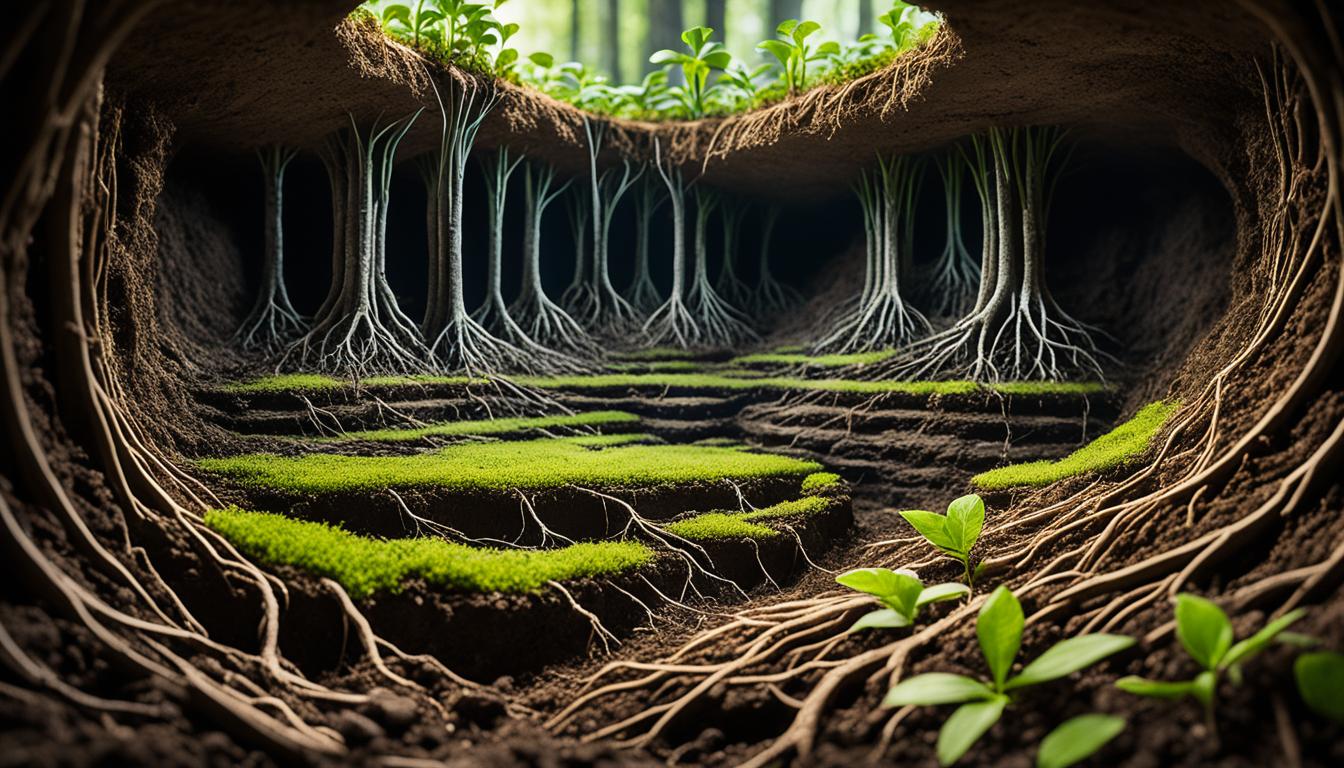
Did you know that the voluntary carbon market saw big growth, going from $2 billion to $40 billion by 2030? It’s all thanks to soil carbon sequestration. This process can store 5 gigatons of CO2 every year until 2050.
Adding soil carbon sequestration to farming not only boosts crop yields. It also improves the health of the land. This change makes the soil better at holding water, nutrients, and forming a strong structure. It helps the earth fight against climate change too.
For example, Groundwork BioAg has a plant booster that increases crops yields by 15% to 30%. Myland offers a service that makes you need less water and fertilisers, yet it improves yields. Andes has a solution that makes soil better for growing plants, increasing farmers’ profits by up to 25%.
Methods like planting cover crops, using less ploughing, and growing trees on farms help store more carbon. But, these ideas need more support. They are slow to catch on because they can be expensive and there are not enough helpful rules. Using new tech and working together can make farms more eco-friendly and strong.
Exploring soil carbon sequestration shows it’s key for fighting climate change. There’s a lot of carbon stored on land, roughly 3170 gigatons. This shows huge potential for improving soil and cutting CO₂ in the air.
About 80% of this carbon, roughly 2500 GT, lies in the soil. Mainly, it’s stored in soil organic matter (SOM). This is why sequestering carbon is great for soil health.
Comparing it, the soil carbon pool is 3.1 times bigger than the air’s carbon. This makes a strong point for concentrating on soil carbon sequestration. It enhances soil health, by bettering water and nutrient holding.
Our demand for carbon sequestration is rising. The air’s CO₂ has jumped to 381.2 ppm by 2006, from 280 ppm before 1850. It’s time to act, to stop CO₂ from growing more.
Soil stores carbon better than oceans, at 3 GT C each year versus 2 for oceans. This makes soil carbon storage key in fighting climate change.
Businesses aiming for zero emissions are turning to soil sequestration. They see it as a top way to battle climate change. It could cut 5 gigatons of CO₂ yearly by 2050, doing better than other methods.
To sum up, soil carbon sequestration is about more than just helping with the climate. It improves soil, encourages sustainable farming, and is vital for our environment’s future.
Understanding soil carbon storage involves knowing how carbon gets locked up in the ground. Soil holds about 80% of the world’s carbon, which is a huge 2500 gigatons. Much of this is in the form of organic matter. This amount of carbon in the soil is over three times that in the air we breathe.
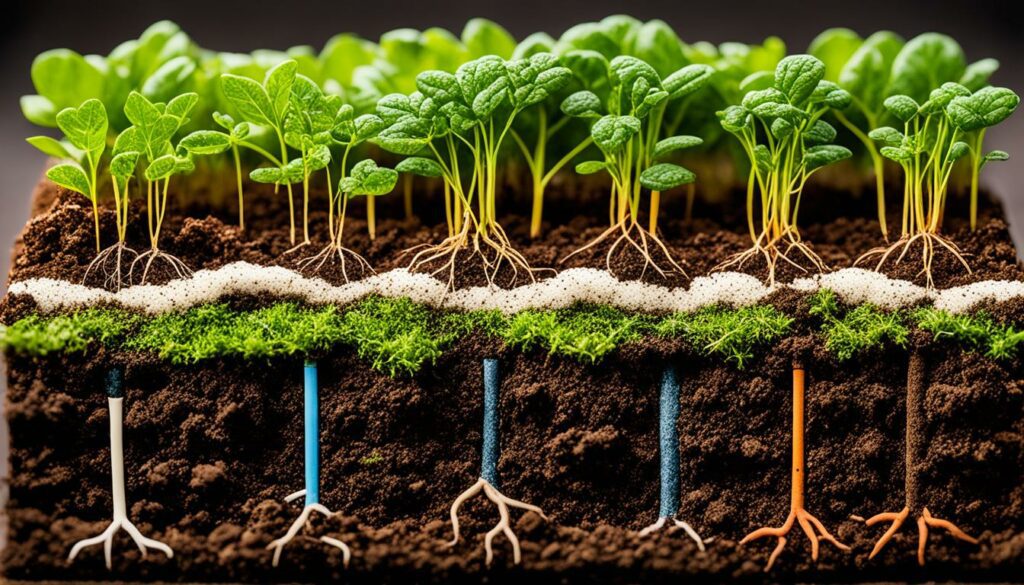
Carbon storage begins with plants. Through photosynthesis, they take in carbon dioxide from the air and turn it into organic matter. When plants die, this carbon goes into the soil. Here, it plays a crucial role in keeping the soil healthy. About 3 gigatons of carbon are added to the soil each year, coming mostly from plants. This is more than what oceans do, even though they cover most of the Earth.
In the past, the amount of CO2 in the air has gone up, from 280 parts per million to over 381 parts per million by 2006. This rise happens because we burn fossil fuels and change how we use the land. These changes can lead to more carbon in the air and less in the ground.
Microorganisms, like fungi, are key in keeping carbon in the soil. They work with plant roots, turning plant waste into substances that stay in the soil for a long time. This process boosts the amount of carbon soil can hold, helping to fight climate change.
This link between tiny soil creatures and carbon storage is very important for battling the effects of climate change. By 2030, we could add 5.3 gigatons of carbon to soil every year. Such a move could do a lot to ease the harm caused by too much CO2 in the air.
| Component | Carbon Storage (GT) |
|---|---|
| Total Carbon in Terrestrial Ecosystems | 3170 |
| Soil Carbon | 2500 |
| Organic Soil Carbon | 1550 |
| Inorganic Soil Carbon | 950 |
| Atmospheric Carbon | 800 |
Soil carbon storage offers a way to help against climate change. Microbes are vital in this effort. They do a lot to make sure carbon stays in the soil for a long time.
Soil carbon sequestration deeply influences soil health. It boosts soil’s structure and aids in holding water better. It also helps in nutrient cycling and increases soil fertility.
In my work, adding carbon to the soil has improved its structure. This made the soil more “fluffy” and let water and air move through it better.
Adding things like compost and biochar changes the soil visibly. These changes make the soil better for plants by making space for roots and water.
When soil is healthy, it can hold more water. This means it’s better at dealing with dry periods and keeps plants from drying out. This can reduce the need for extra watering in farming.
Making sure nutrients move well in the soil helps plants grow strong. Adding things to the soil like compost makes sure plants get what they need. This helps them fight off insects and diseases.
It also makes the farm more productive. This is good for the environment and for farmers.
The link between adding to the soil and fighting climate change is key. Good soil practices help farming last for a long time, and they protect the land.
Sustainable farming is vital for big carbon sequestration and soil sustainability. Important methods include cover cropping, reduced tillage, agroforestry, and managed grazing. These techniques are key in making the earth healthier by restoring its soil and boosting its organic matter. For instance, cover crops shield the land and add nutrients. They help in making farm systems strong enough to absorb large amounts of carbon.
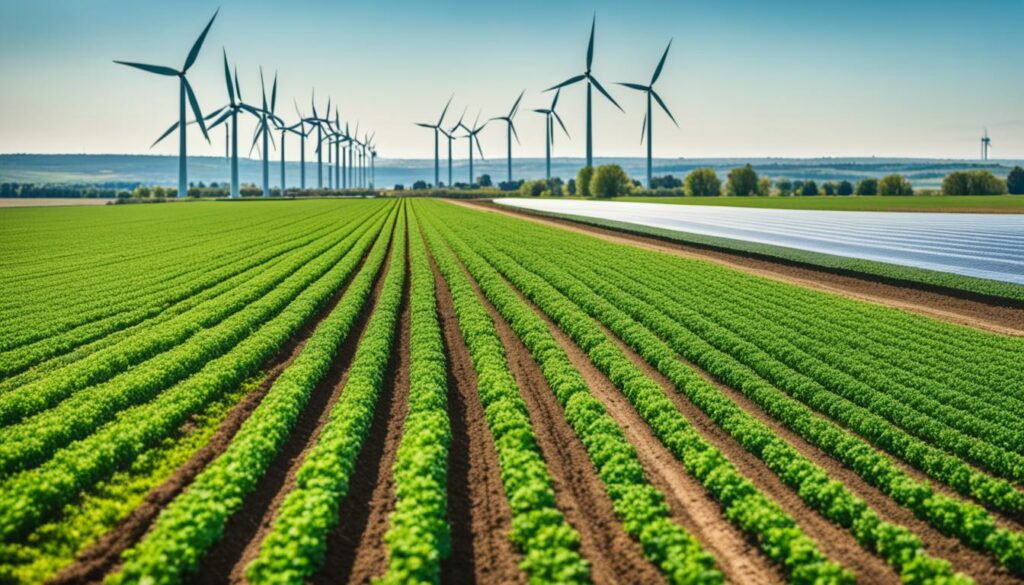
The good effects of these farming ways are huge. In the last 12,000 years, farming has let out 133 billion metric tons of CO2. This has greatly added to climate change. But, farming can trap up to 5.3 GtCO2 per year by 2030. This is according to the IPCC. Less use of chemical fertilisers and smarter nutrient use make the results even better.
Some farmed soils have lost up to 70% of their original organic carbon. This is because of usual farming. Switching to sustainable ways can greatly preserve soil. The USDA’s Conservation Reserve Program aims at this. It tries to hold more carbon in farm lands. It shows a strong effort to make soils healthier and save more carbon.
Moreover, techniques like regenerative farming keep soil alive. It means farming with very little digging. This doesn’t just stop soil from washing away. It also saves more carbon. This helps the crops grow better and continues the soil’s wellbeing. Agroforestry is another good move. It mixes trees and crops, giving space for more carbon. It also helps farms be more productive and supports many kinds of life.
| Practice | Effect on Soil Conservation | Carbon Sequestration Potential |
|---|---|---|
| Cover Cropping | Reduces soil disturbance, builds fertility and organic matter | High |
| Reduced Tillage | Preserves soil structure and quality | Moderate |
| Agroforestry | Enhances biodiversity and farm productivity | High |
| Managed Grazing | Improves soil organic matter and nutrient cycles | Moderate |
Using these farming methods helps us keep the soil rich and trap more carbon. This balances good farming production with taking care of the environment.
Cover cropping helps store carbon in the soil, which has many good points. Not only does it capture carbon, but it also helps in farming. It makes the soil better for growing crops.
By planting cover crops across 20 million acres, about 60 million metric tons of CO2 could be sequestered each year. This is like taking 12.8 million cars off the road. Crops like cereal rye and crimson clover are great at this. They also protect the soil from washing away, stop weeds, and keep water in the ground.
These cover crops are good for the soil for a long time. They make the soil healthier by their roots and plant parts. This extra growth improves the soil a lot.
To get the most carbon in the soil, choosing the right plant is key. Crops that leave a lot of plant matter behind, like cereal rye, are a good choice. It’s also important to plant them when they can grow the best.
Planting more than one crop in a field can make the growing season longer. This helps the soil stay healthy and put more carbon away. Rotating crops also helps keep the soil in good shape. But, to know how well these methods work, we must test the soil deeply.
Research shows that using cover crops can increase certain soil parts by about 5%. And, in some places, it lifts the overall organic matter by 14%. This means cover crops are not only good at storing carbon. They also help the soil stick together better and keep the carbon for a long time.
Reduced tillage practices help store carbon in the soil by disturbing it less. This way, more organic matter stays in the soil. It makes the soil healthier by improving enzyme activity, keeping soil together better, and reducing how much soil washes away.
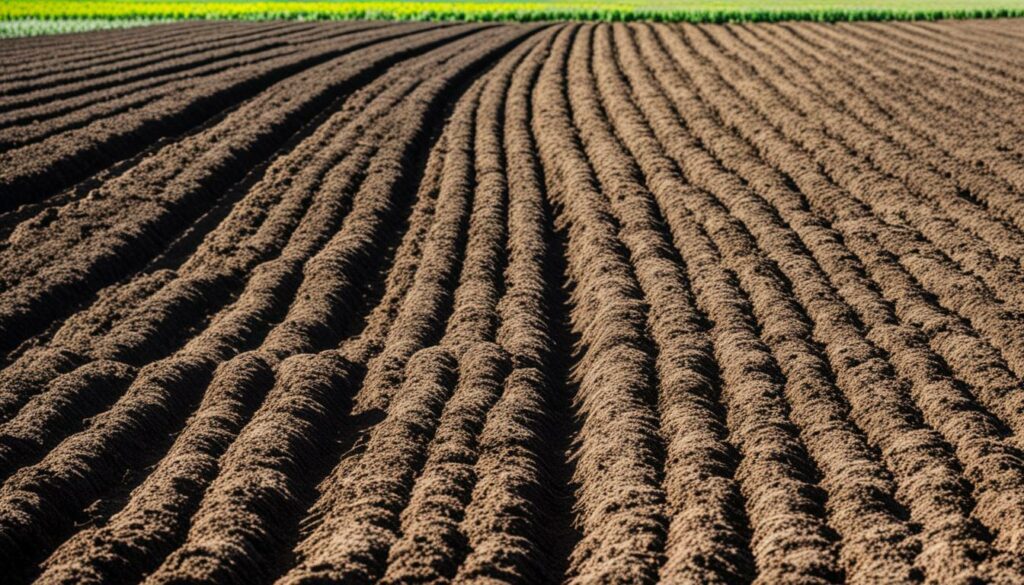
Reduced tillage means using methods that don’t plough the land much. This keeps the soil’s natural bits and its life alive. Research shows that doing this not only makes the soil better but also traps more carbon from the air (Kumar et al., 2017).
There are lots of good things that happen with reduced tillage for the soil. Clear advantages include:
Experts also say that farming practices that cut tillage and leave the soil alone increase the amount of carbon-rich material near the surface. This boosts how well the soil can grow plants. Areas where the land isn’t ploughed so much have more of this kind of material than places where it’s heavily worked (De Moraes Sa et al., 2001; West and Post, 2002).
| Study | SOC Comparison | Depth |
|---|---|---|
| Bai et al., 2008 | Higher in NT vs. HT | 0-30 cm |
| Olson et al., 2016 | Significant difference in IT vs. HT | 15-30 cm |
| West and Post, 2002 | Higher SOC in NT | Upper soil layer (0-15 cm) |
It’s clear that using reduced tillage is very beneficial. By farming this way, we make the land better and help fight climate change.
Agroforestry mixes trees with farming, bringing the good of carbon storage in soil and more life. This way, trees and crops help each other, leading to better soil and a more stable ecosystem.
Putting trees with crops boosts the soil’s carbon storage. Trees keep carbon in their roots and leaves, while crops add more during the year. Together, they make the soil richer and more alive for tiny organisms.
In the tropics, mixing trees with crops shows great promise for keeping carbon. Latin America, for example, has shown how well these systems store carbon. And in places like Costa Rica, using trees like cacao, laurel, or poro gives even better results.
Agroforestry systems are also great for wildlife. Mixing different plants makes homes for many creatures, making things more balanced. This helps control pests and helps plants reproduce, keeping farms healthier.
Turning tropical areas into farms can lower the carbon in the soil, but not with agroforestry. It keeps the soil carbon high and helps the little creatures living in the ground. This makes the soil healthier and more steady.
In short, agroforestry blends farming and forests for a win-win. It helps keep carbon, makes homes for animals, and keeps the land strong.
Next-generation soil carbon sequestration techniques are changing how we look at storing carbon. New methods include using biochar, enhanced rock weathering, and helping soil microbes. They boost how well soil can keep carbon, helping fight climate change and making soil healthier.
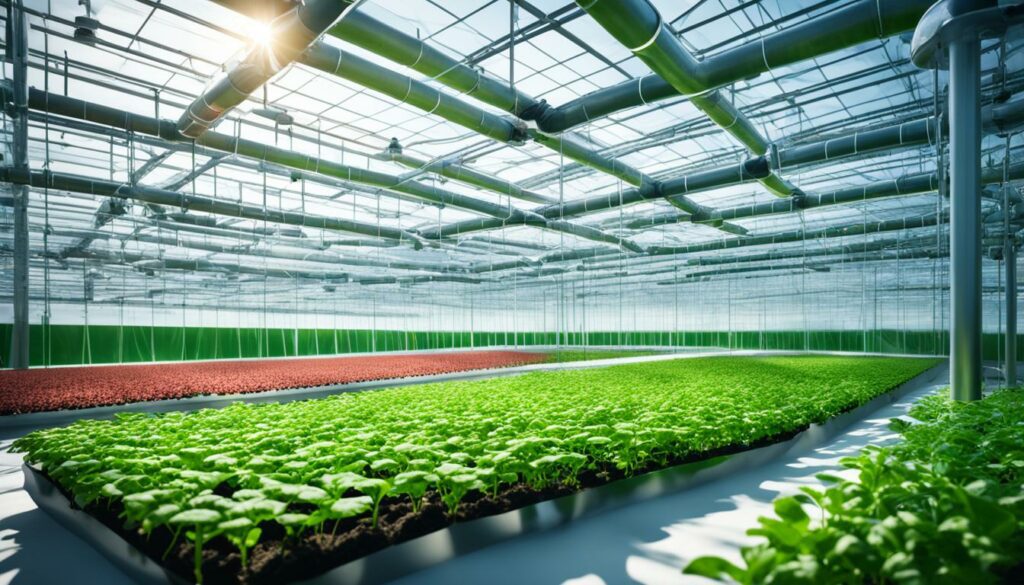
Biochar is made by heating plant matter without air. This makes a very stable form of carbon. It doesn’t just lock away carbon; it also makes soil better at holding water and nutrients. Studies show it lasts a long time in soil. Places like Net Zero are using lots of biochar in the tropics. They aim to help farming and cut a lot of CO2 from the air.
Using finely ground rocks can make soil soak up CO2. It makes a type of stable carbon over time. Research says it can store 3 to 4 tons of CO2 per acre for ages. By spreading rocks, UNDO Carbon is finding success worldwide. This process is fitting in many farming places.
Microbes are becoming champions in trapping carbon in soil. Products from companies like Groundwork BioAg can turn old carbon into new, stable forms. And Andes makes soil treatments that help water and nutrients reach plants better. Myland’s approach has also helped farmers use fewer resources and earn more.
| Technique | Carbon Sequestration (tons CO2/acre) | Benefits | Leading Companies |
|---|---|---|---|
| Biochar Application | High permanence, variable amounts | Improves soil structure, water retention, nutrient availability | Net Zero |
| Enhanced Rock Weathering | 3-4 tons | Long-term carbon storage, enhances soil mineral content | UNDO Carbon |
| Microbial Inoculants | Variable with soil type and crop | Enhances soil carbon stability, improves crop yields | Groundwork BioAg, Andes, Myland |
Using soil carbon sequestration in farming has big economic benefits. It makes soil healthy, which helps the environment and your wallet.
A key gain is much increased crop yields. When soil is full of organic carbon, crops grow better. They can handle bad times and grow more. This means you get more food from your harvests.
Reduced fertiliser costs are also a plus. Good soil structure and natural nutrient cycling cut down on chemicals. This saves money for farmers. It also means farming can keep going strong without harming the Earth.
Keeping the soil healthy for the long haul is crucial. Without good care, soil can get weak and lose its nutrients. This makes farming hard and bad for the planet. But choosing methods that build up soil health can ensure the land stays good for growing food. Organizations like Net Zero and UNDO Carbon are helping farms do this. They offer ways that are good for business and the climate.
Below is a table that shows the good things about using soil carbon sequestration in farming:
| Benefit | Description |
|---|---|
| Increased Crop Yields | Higher production due to better soil health and nutrient availability |
| Reduced Fertiliser Costs | Less reliance on chemical fertilisers due to improved nutrient cycling |
| Long-Term Soil Health | Maintained soil productivity and sustainability over time |
While there are many good things about soil carbon sequestration, adopting it is hard. Big problems stop people from using these great methods. To get more people using them, these challenges must be tackled.
High costs at the start and waiting a long time for profits are major issues. These problems keep farmers from choosing methods that make soil rich in carbon. This is even trickier for farmers in poor countries. They often need quick money or food safety more than they need to fight climate change.
Not having clear, good policies also makes it hard for farmers. They find it tough to get help or rewards to ease the money stress of changing their ways. Although the US Department of Agriculture is working on this, we need stronger rules to help more people start using these methods.
Many farmers don’t know how to use soil carbon methods well because they lack help. Having experts guide them is key. They need to learn what works best and how to fit these methods into their farming. With more help like this, many more farmers could succeed.
| Barrier | Concern | Example |
|---|---|---|
| Economic Constraints | High initial costs and delayed returns | Developing countries prioritising immediate benefits over long-term mitigation |
| Policy Frameworks | Lack of clarity and support | US Department of Agriculture’s ongoing efforts yet needing more comprehensive policies |
| Lack of Technical Assistance | Insufficient guidance for effective implementation | Need for more technical support to guide farmers |
Ensuring that soil carbon sequestration projects work well is vital for sustainable land management. Many funds are being used to make the methods to check and confirm these projects better and more accurate.
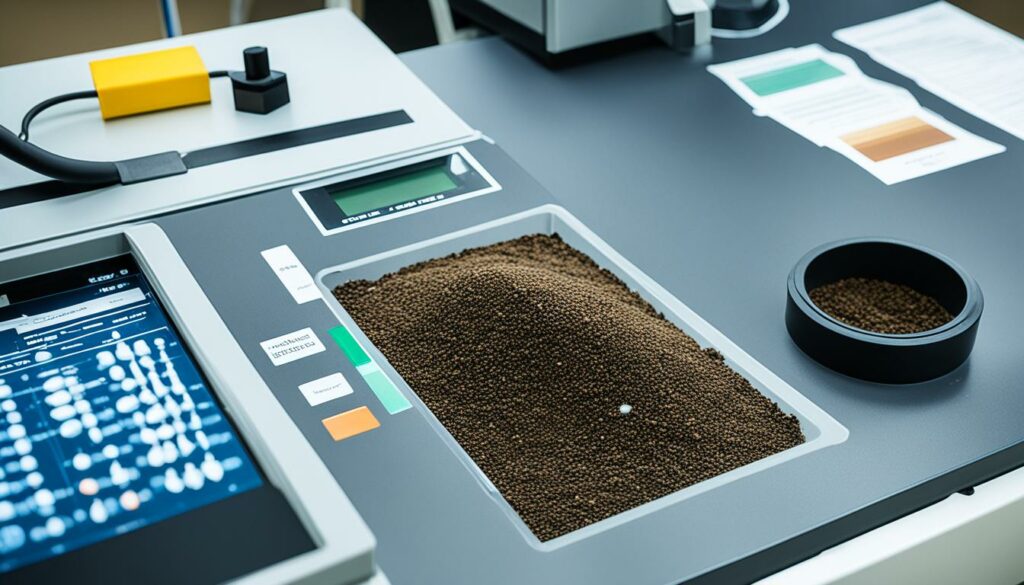
Measuring soil carbon correctly is key to showing the true effect of these projects and building trust among those involved. A new initiative in the U.S. is working on better ways to measure soil carbon on special farming lands. Michigan State University is also measuring carbon in these areas to have a clear look at their impact over five years.
At the same time, scientists from Mississippi State University are gathering data on soil and air carbon improvement at various sites in the country. Ducks Unlimited and others are helping, too. They are studying carbon levels in 250 wetlands across 15 states in the U.S.
New methods are being designed to meet the challenges posed by innovative ways to remove carbon dioxide from the atmosphere. These methods aim to provide exact data to back up the claims about carbon sequestration. The Coordination for Soil Carbon Research and Monitoring Act set up a Committee led by the White House. This Committee is working on a plan together to improve how we sample and measure soil carbon, using the latest tech.
They are regularly updating Congress on their work to be open and responsible. This focus on monitoring, researching, and improving measurement methods is key. It will help the U.S. make the most of soil carbon sequestration. And, it ensures that we keep up with the latest technologies and ways to measure soil carbon accurately.
Good policy suggestions are key to making soil carbon sequestration better in farming. These rules must really help farmers and ranchers. They should make it easier to use sustainable ways and handle the costs and challenges.
There needs to be federal help and money to make the switch to better farming. This will ensure more farms use carbon-rich methods widely.
Supporting farmers and ranchers is crucial for storing carbon in soil. They need practical steps and advice on methods like cover cropping and agroforestry. Policies should help all, especially those on small or rented farms, to join in.
Federal funding and incentives are essential for better soil carbon sequestration. Acts like the Growing Climate Solutions Act help farmers work with carbon markets. More support for existing programmes, like the USDA’s CRP, can improve how much carbon gets stored.
Providing money that matches what farmers could earn in carbon markets, about $15 to $20 per metric ton, is also vital. This motivates the use of these greener technologies.
Making sure everyone has equal chances to use these methods is crucial. Farmers who haven’t had much help before should get the support they need. Policies must work for all types of farms in the U.S. to make a real difference.
This can help against the problem that many farms can’t use the full benefits of carbon markets.
Creating fair access is needed, as shown in the table below:
| Potential Benefits | Existing Barriers |
|---|---|
| Mitigation of up to 5.3 GtCO2 per year by 2030 | Economic constraints, initial high costs |
| Enhanced soil health and agricultural resilience | Policy frameworks lacking clarity and support |
| Access to expanding carbon markets | Lack of technical assistance and resources |
Supporting farmers, increasing federal help, and ensuring everyone can use these methods is key. This will change how we store carbon, support green farming, and fight climate change.
Agroecology plays a key role in increasing soil carbon storage. It combines biodiversity, services that ecosystems provide, and strong food systems. By doing this, agroecology helps in creating production methods that store a lot of carbon. The soil is after oceans in how much carbon it holds. Put together, they are crucial in the world’s carbon cycle.
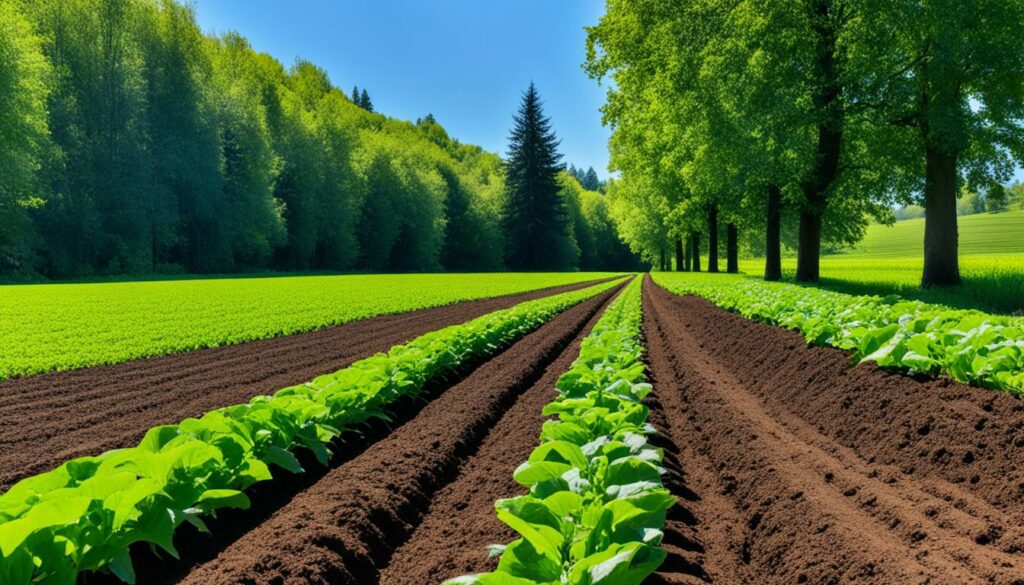
The European Commission wants to make 75% more soils healthy by 2030. This highlights how important agroecology is. Farming has been harming our soils globally. This has caused the amount of carbon in the soil to drop. Soil organic carbon (SOC) is key in the carbon cycle and shows how healthy our soil is.
Choosing regenerative farming, like agroforestry, can boost how much organic carbon soils store. It also involves cover crops, mixing animals into farming, and other steps. These practices make the soil healthier. They also help keep more carbon locked away.
Many farmers and a lot of science are focusing on being more regenerative. They try to make the soil healthier and store more carbon. Crops like grapes can store a lot more carbon when farmed regeneratively. This shows we need to mix agroecology with regenerative farming for the best results.
For the soil to keep its carbon, we need broad regenerative farming based on agroecology. Soil at the top is full of carbon – more than the air’s carbon. But, turning wild areas into farms makes us lose a lot of this soil carbon.
Not tilling the soil much can help keep more carbon in the soil. This, combined with always covering the soil and changing the crops grown, is good for the carbon in the soil. Sticking to these ways for a long time is what really makes a difference.
Using regenerative farming can be hard, like when you need maize stalks for the soil but also for your animals. Still, with hard work and by keeping to agroecological principles, we can overcome these problems. This leads to more carbon in the soil and better soil health.
| Practices | Description | Impact |
|---|---|---|
| Agroforestry | Combining trees with crops | Increases carbon storage and biodiversity |
| Cover Cropping | Planting cover crops between main crops | Prevents erosion and enhances soil organic matter |
| Animal Integration | Incorporating livestock in farming systems | Improves nutrient cycling and soil structure |
| No-tillage | Minimising soil disturbance | Reduces soil erosion and maintains carbon stocks |
Soil carbon sequestration helps tackle climate change by reducing greenhouse gases. It traps carbon dioxide, keeping it in the soil instead of letting it into the air. This way, we slow down the rise of CO2 that comes from human activities.
It’s crucial to support soil carbon sequestration to cut down on greenhouse gases. This method can remove a significant amount of carbon from the air. It’s key to meeting the EU’s goals for reducing emissions, which were already achieved by 2020.
Strategies that focus on ecosystems also help improve productivity and lower the need for fertilisers. By increasing soil organic carbon, we can produce better crops with less harm to the environment. This is especially vital for areas like sub-Saharan Africa and parts of Asia, where farming must change.
Working on soil carbon sequestration does more than cut greenhouse gases. It also makes ecosystems stronger and better able to handle changes in the climate. With so much soil already damaged by past farming, restoring its health is very important.
Improving soil health through these strategies benefits everyone. But, since soil is mostly managed by individual farmers, we need to figure out better ways to encourage these efforts. Governments should make policies that help all farmers take part. This way, we can make ecosystems everywhere more resilient.
The world of soil carbon sequestration is full of success stories. These stories show how new ways can work well and help the environment. Myland and Groundwork BioAg are leaders in this field.
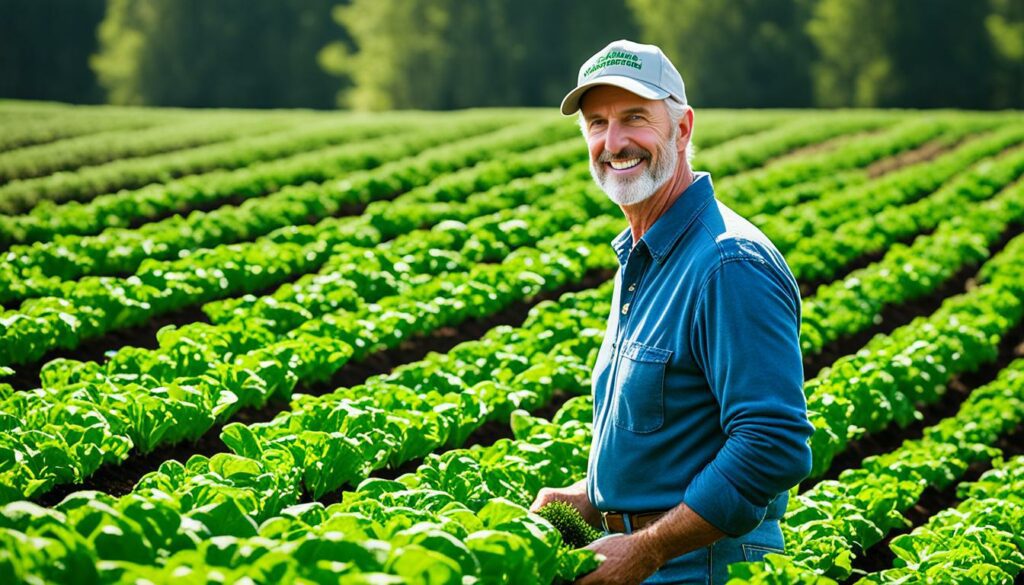
Myland changed the game with its ‘Soil as a Service’ model. They work on improving soil health using technology. This has led to better carbon storage. Farmers using Myland have seen more crops without using as many chemicals. This new way helps farms be more productive and friendly to the planet.
Groundwork BioAg is known for its mycorrhizal inoculants. These help plants by making nutrients easier to grab and keeping soil healthy. Using these inoculants makes crops stronger and more plentiful. They also help farms stay healthy over the years by needing less chemicals. This supports a way of farming that takes care of the soil for the future.
By looking at examples like Myland and Groundwork BioAg, we see how important these successes are. They show how good techniques can help a lot and be used widely. Learning from them is key to making farming better and more sustainable.
The future’s bright for soil carbon storage thanks to new tech and changing carbon credit markets. Innovations like biochar, enhanced weathering, and using microbes are making efficient carbon storage possible. These advancements are key to making carbon sequestration more effective and widespread.
Today, we’re seeing big changes in how we store carbon in soil. Biochar, a type of stable, carbon-rich biomass, helps keep carbon in the ground for a long time. Enhanced weathering is another method. It’s about scattering finely ground rocks on fields to capture CO2 from the air faster. Also, adding certain microbes to the soil boosts how much carbon we can store.
The evolution of carbon credit markets is very important for the future. These markets encourage farmers to store more carbon. But, we need to be careful not to think of soil carbon mainly as a way to make money. It’s more important for the earth and our climate.
Not many farming organisations have clear goals that help the planet. Still, nearly 4,000 out of 6,800 have started working on storing more carbon in the soil. This new focus is important, but we need to do a lot more.
| Factors | Statistics |
|---|---|
| Agriculture- and food-related organisations with science-based GHG reduction pathways | 58% |
| Organisations with targets aligned with Paris Agreement | 17% |
| Organisations with quantitative soil carbon targets | 3,928 of 6,779 |
In the end, the future of soil carbon storage relies on both new technology and changes in the carbon market. By adopting these new methods and trends, we can do a lot more to keep carbon out of the air. This helps both the planet and the economy.
To tackle the big task of boosting soil carbon sequestration worldwide, we need a mix of efforts. This combination includes working together across countries and using methods that suit each area’s needs. This way, we make sure our actions have the biggest impact.
Working together on a global scale is key to increase soil carbon sequestration. Countries share what they know and learn from each other. This is vital in the fight against climate change.
The “4 per 1000 Initiative” is a great example of countries teaming up. It aims to grow soil’s organic carbon by 0.4% every year. This effort shows how global unity can boost soil health and improve agriculture’s strength against change.
Groups like the Food and Agriculture Organization (FAO) and the UN help by offering advice and technology. They are also key in setting up how we work together. From 2009 to 2018, the world saw a big jump in CO2 emissions. Tackling this requires everyone to join hands.
Local strategies are just as vital, tailoring solutions to local needs and resources. Places with high agricultural potential but low yield, such as sub-Saharan Africa and South and West Asia, should be focal points. Increasing soil organic carbon in these areas can significantly improve crop yields while reducing the need for chemical fertilisers.
These local efforts should also combat widespread soil degradation. A third of the world’s soils are in bad shape due to past farming practices. Restoring these soils can make a big difference in fighting climate change. With soil management often in the hands of individual farmers, local research is key. It should focus on advising farmers directly, on how to boost carbon storage on their land.
Working globally and locally in harmony is essential for tackling the challenge of boosting soil carbon sequestration. These combined efforts tackle various challenges, like ecological differences, varied economies, and differing cultures. They ensure that our plans are not only needed but also successful in the long run.
Soil carbon sequestration is key in facing today’s environmental problems. It offers a way to store a lot of carbon. This helps fight climate change, supports better farming, and keeps soil healthy.
There’s more carbon in the soil than the air. This shows how important soil is for handling carbon worldwide. By storing CO2 from the air, soil carbon sequestration boosts soil health. It leads to better farming and makes ecosystems stronger.
To make these practices bigger, we must deal with money challenges and improve how we check progress. Fair rules that help all farmers are vital. Acts like the Growing Climate Solutions Act and schemes such as the USDA’s Conservation Reserve Program help a lot. They make it easier for farmers to join in, sell carbon, and boost carbon storage. Let’s keep working for a healthy planet. Soil carbon sequestration is a major step towards that goal.
Soil carbon sequestration is capturing carbon dioxide from the air. It stores this carbon in the soil as organic matter. This process makes the soil healthier. It also helps in farming in a way that protects the environment. Moreover, it is very important for dealing with climate change.
It makes the soil better in several ways. For example, it helps the soil hold more water. It also helps plants get more nutrients from the soil. This way makes farming more productive and the environment stronger.
Microbes, like fungi, work with plant roots to store carbon in the soil. They change carbon into forms that stay in the soil longer. This way, the soil can keep carbon for a long time.
Cover cropping and agroforestry are good practices for keeping carbon in the soil. They make the soil richer and are good for the environment. Managed grazing is also helpful. It makes the land better and stores more carbon.
Cover crops do a lot for the soil. They stop soil from washing away and keep weeds down. They also help the soil hold onto moisture. Farmers choose them carefully and plant them at the right time. This makes the soil more fertile and keeps more carbon in it.
Reduced tillage means not stirring up the soil so much. This keeps its natural matter and structure better. When farmers do this, the soil doesn’t lose as much carbon. It also helps the soil keep healthy bacteria and other tiny living things. This leads to more active soil, less erosion, and better for the earth.
Agroforestry makes a farm more like a natural forest with trees. It helps the soil store more carbon. It also makes homes for wildlife. This helps the whole area stay strong against changes. So, it’s good for the earth and for farming.
New ideas for keeping soil carbon include using special kinds of charcoal. Big rocks can help keep carbon too. Also, special soil bacteria can work to keep carbon trapped in the ground. These are new and smart ways to help the earth and are getting better all the time.
Doing things to keep more carbon in the soil can make more food. This means farmers spend less on things to help their crops grow. Their land stays healthier too. This all means they can make more money in the long run. So, it’s good for the farm and the earth.
It can be hard to start doing things for the soil because it costs money. There aren’t always clear rules or support to help. Stable help, both with money and advice, is needed to overcome these problems.
To know how well we’re doing, we must check and control often. New ways to test the soil are being made. This helps everyone trust that soil-saving actions are really working. It also helps make fair plans for the future.
The government can help by giving money and making rules. This will make it easier for all types of farmers to save the soil. If everyone has what they need, they can all help make the earth healthier. This way, farming can be more enduring and kind to nature.
Agroecology means farming in a way that’s good for nature and provides food. It uses wisdom from the land to grow food. This keeps the soil’s health and stores carbon in the ground. It’s a way of farming that works well with the world we live in.
By keeping carbon in the soil, we take less greenhouse gas from the air. This is good for the air and the ground. It also helps nature be strong against changes. So, it’s a big way to help fight for a cooler, safer earth.
A special soil service and fungi that help plants are showing us new paths. They make the land better and save water. This makes food-growing last longer and helps the earth stay healthy. They are a sign that farming can be better for all.
New things like better rocks and useful bacteria are coming. They say we can put more carbon away and do it well. This is exciting because it means we have more ways to care for our land and planet. More people are helping by joining in and that’s great news.
Working together across the world, people can do a lot to keep carbon in the soil. By sharing good ideas and knowing what’s best for each place, we can all help. This way, everyone does their part to make the earth’s future more sound and green.